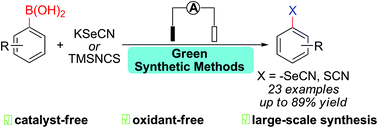An electrochemical method for deborylative seleno/thiocyanation of arylboronic acids under catalyst- and oxidant-free conditions†
Abstract
An electrochemical deborylative seleno/thiocyanation of arylboronic acids has been well established to synthesize the corresponding aryl seleno/thiocyanates with good functional group tolerance under ambient conditions. A gram-scale reaction has been performed to highlight the advantages of the protocol. Preliminary mechanistic studies indicate that the oxidation of the seleno/thiocyanate anion occurs prior to that of the arylboronic acid substrate in galvanostatic mode, and that free radicals are involved in the process.



 Please wait while we load your content...
Please wait while we load your content...